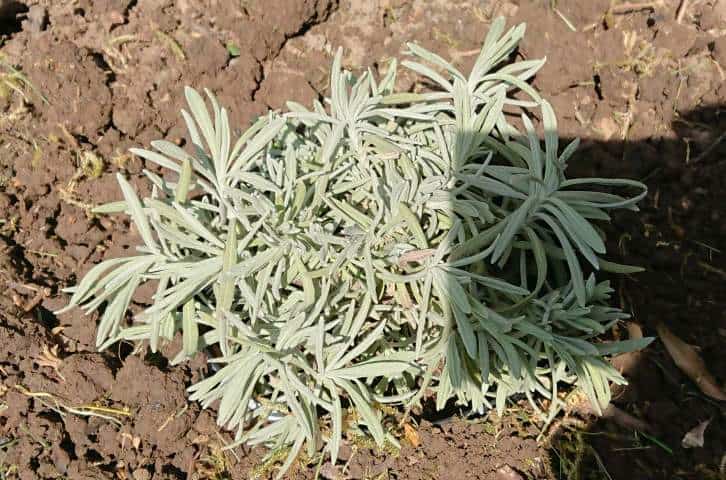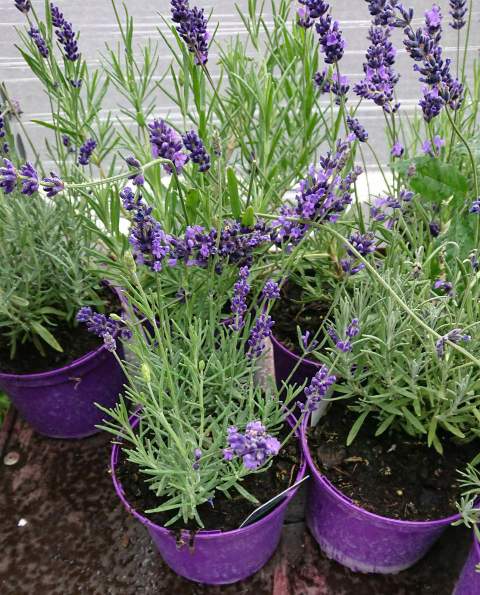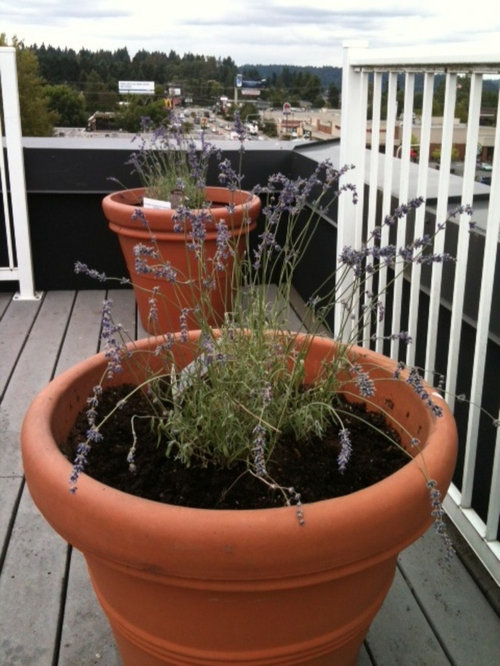
The most frequent cause of newly planted lavender wilting is stress brought on by over watering. Lavender that has just been planted needs just enough moisture to encourage the roots to take hold, but too much water risks causing root rot, which makes the lavender wilt.
When established after many months, lavenders are drought-resistant plants, but they need a specific amount of irrigation after planting to support the establishment of their roots.
The trick is to find a balance between watering the new lavender plant just enough to prevent transplant shock and not enough to keep the soil continuously moist.
For a few more tips on how to take care of freshly planted lavender and stop it from drooping, keep reading.
Table of Contents
1. Watering Newly Planted Lavender
The key to watering newly planted lavender is to water it frequently enough for the roots to take hold without the soil remaining permanently wet. Lavenders need a few weeks to get used to their new environment before they can survive in hot and dry circumstances.
If you water your plants too often, the soil will become wet and the plant may wilt as a symptom of stress.
You must be aware of how much water to provide your lavender plants in order for them to grow properly without wilting.
Keep in mind that when watering lavender, you should always give it a good soak. When watering lavender, consider “soak and dry” rather than “little and often” to ensure that the roots grow well and establish in the soil.
| Lavender Plants Just Planted | How Much Water to Use |
| A withering lavender plant | Reduce watering if you are giving the lavender daily irrigation. Reduce the amount of watering and let the soil partially dry between applications. Make sure the lavender is planted in soil that drains properly, in full sunlight, and with watering every three days for the first two weeks as the roots grow. For the first month, reduce watering to once per week. If there hasn’t been any rain after a month and the soil seems dry, water once every two weeks. |
| Unreasonable Heat | In extreme heat, newly planted lavender plants need to be watered more regularly to prevent wilting, while the soil should be left partly dry in between watering sessions. In most circumstances, watering generously every three days should be sufficient to keep fresh lavender plants healthy and prevent wilting brought on by too dry conditions. Adjust your watering frequency to reach this equilibrium in your area. |
| Large-scale rainfall: | If you live in a temperate region with persistent rain and overcast skies, it may be beneficial to move newly planted lavender out of the rain if it is in pots or provide protection if it is in the garden so that it does not have to endure as much moisture. Due to their preference for well-draining soil, fresh lavender plants might wilt in soil that is regularly moist due to rainfall. |
Due to their drought resistance, lavender is much more susceptible to overwatering than underwatering.
The lavender should resume its more typical appearance once you have reduced watering and given the soil time to dry out.
2. Plant with the Appropriate Soil

- Quite depleting (preferably somewhat sandy)
- medium to low fertility
The soil might be too damp for the lavender, which could explain why it is wilting and even lead to root rot, if it is planted in heavy soil like clay (which drains slowly) or close to bogs.
Dig a hole that is considerably larger than the root ball of the lavender plant, and then backfill it with about 1/3 horticultural sand or grit and 2/3 compost.
(Read my article on the ideal soil mix for lavenders for additional information.
This will make sure that the soil structure of the lavender closely resembles that of the coastal Mediterranean, which is where it naturally grows, and that it drains just enough.
I always advise planting lavender in pots if your garden soil is heavy clay since you can simply create the ideal conditions by adding sand or grit and controlling the soil profile.
In fresh, ideal soil, wilting lavender should begin to appear healthy once more after a few days.
The fact that lavender actually prefers low to medium fertility soil might occasionally surprise gardeners.
The high nitrogen concentration will encourage excessive stem and foliage growth with fewer flowers if the soil is excessively nutrient rich, which might result in a withering appearance frequently with yellow leaves.
Horticultural sand or grit are the ideal soil additions to provide the low to medium fertility soils that lavender needs to thrive and produce potent smells and a show of blooms while also providing the ideal balance of soil nutrients to counterbalance excessively fertile soils or compost.
When planting lavender, stay away from using enriched compost and mix in some sand to reduce the amount of nitrogen in the soil, which might cause a wilting plant.
3. Do not Fertilize Your Newly Planted Lavender
New lavenders shouldn’t receive any fertilizer of any form, as fertile soil goes against what they prefer for a soil environment.
As you plant your lavender, combine some compost with the sand or grit to provide all the nutrients they need.
The same reasons that nutrient-rich soil causes plants to grow lanky and wilt also apply to more fertilizer.
Contrary to many other plants, lavender has evolved to thrive in medium to low fertility soils, where they also smell their finest and produce the strongest blooms.
I advise urgently transferring your lavender to another pot or part of the garden with new soil if you have added fertilizer and it is withering.
Fertilizer-stressed lavender plants are frequently more prone to fungus-related illness.
The lavender should fully recover after being moved to new soil.
Compacted soil
For newly planted lavenders, too compacted soil can also be problematic. Because your freshly planted lavender appreciates nicely aerated soil, don’t press the dirt after planting the lavender.
As a result, the soil’s capacity to breathe and to drain will be reduced, both of which might lead to the wilting of lavender.
If you amend the soil with horticultural sand or grit instead of fine sand, the soil will be more porous and open, allowing for the exchange of oxygen and carbon dioxide for root respiration as well as ensuring that water can permeate the soil.
4. Planted Lavenders in a Large Enough Pot
Only when newly planted lavenders are placed in extremely small pots do I observe them wilting from a lack of moisture in the soil.
Even if the lavender is a smaller kind like lavender Hidcote Superior, plant it in a planter that is 12 to 16 inches across.
The plant will wilt even with the right amount of watering if the pot is too tiny, made of plastic or metal, and can quickly heat up and promote soil evaporation to a level where the new lavender’s roots do not have enough time to absorb the water they require.
When you plant lavender in a container that is 12 to 16 inches across, you can be confident that there will be enough soil in the container for the roots to have room to spread out, establish themselves appropriately, and get enough water and nutrients.
Additionally, more dirt insulates the lavender roots from the cold.
The wilted lavender should revive if you transplant your new plant into a larger pot and give the soil a good soak so that water drips out the bottom.
Read my article on picking the perfect pot for lavenders to find out more about the best pots and containers.
5. Pots Without Drainage Holes Cause Wilt

Lavenders are often planted in pots without drainage holes or with drip trays to catch water that leaks out the bottom, which is a typical mistake.
Pots with poor drainage just accumulate water, which keeps the soil perpetually damp. Wilting is one of the earliest symptoms of stressed soil because the water cannot drain away, which causes stress.
However, the pot must have a drainage hole at the base for it to develop healthily. Lavenders grow particularly well in pots as they frequently have better drainage conditions than garden soil.
Lavender should be transplanted into a suitable pot or container, and the soil should dry out in between waterings. Lavender that has wilted should revive in a few days.
Check out my articles on lavender varieties including “Hidcote,” “Munstead,” “Grosso,” French lavender, and lavender in pots for more information on how to care for lavenders.
FAQ
Why is my lavender wilting after being transplanted?
After being planted or moved, lavender plants have a tendency to wilt. This is a typical plant response. The plant will require some time to acclimatize to a change in soil conditions, and while it is undergoing this phase, it will display signs of withering.
Why is my newly planted lavender dying?
The most frequent causes of a dying lavender plant include inadequate watering, excessive fertilizing, an acidic soil pH, illnesses, pests, and insufficient sunlight. To find and address the problem, a thorough examination of the plant and its growing environment is necessary.
How do you revive a dying lavender plant?
Lavender Revival Techniques. If root rot is thought to be present, remove the affected roots and replant the lavender in a soil that drains well. Make sure your lavender, whether it is in a pot or not, gets six to eight hours of sun each day. deep water, but don’t fill it until the top inch (2.5 cm.)
